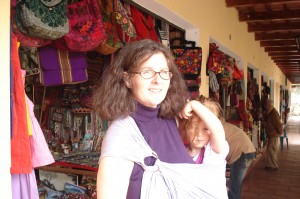By Jeannette Freeman, leader of API of Southeast Texas

On Monday morning, August 1, I woke up with my first contraction at 5:30 a.m. I had another at 6:30 a.m., 7 a.m., and then periodically throughout the day. I was able to continue my usual activities, but by the time bedtime rolled around, I couldn’t ignore the contractions any longer. I tried to get comfortable. I tried everything I could think of. Even took a bath. No luck. I didn’t sleep at all. However, I did everything I could to conserve my energy, knowing I would need it.
Finally, at about 4:30 a.m. on Tuesday, I couldn’t take it any longer and had Mark call the nurse-midwife. I didn’t know how far I’d dilated, but I figured I was at least somewhat along. My water hadn’t broke yet, either, but that isn’t a good indicator of how dilated you are.
We drove into the hospital, went to the triage area, and they checked me out. I was only two centimeters dilated. They had me walk the halls for an hour, from 6:30 to 7:30 a.m. During that time, my contractions went from just being in the front of my abdomen, to going almost all the way around my lower abdomen and back. That’s commonly called “back labor” and was more intense then the previous labor. I also lost my mucus plug. However, I figured out that the contractions were most easily handled if I walked through them.
They checked me again. No changes. I had the option to go home or stay at the hospital. I had no desire to be in the hospital any longer than necessary, so we left. We stopped at McDonald’s to get breakfast.
The morning and early afternoon were spent with a heating pad strapped to my lower back and attached to an extension cord. I lied on my bed between contractions; during the contractions, I would stand up and walk around the bed. Then, I would lie back down. I wanted some stress balls to squeeze but didn’t have any. I instead used two stuffed animals. At about 1:30 p.m., my water broke. It didn’t all come out at once. We called the nurse-midwife, and at some point, we headed to the hospital.
We got there at around 5 p.m. They put me on the monitor for 20 minutes, and then we went to walk the halls. They had a large labor pool, and when we came back from walking, I got into the pool and stayed there for the duration of the first stage of labor. I rested my chin on a pile of towels on edge of the pool and knelt the entire time in the pool. I had the lights dimmed but with no music or background noise. I just went with my body and followed its cues, with a lot of pelvic rocking and loud vocalizations. Finally, at 8:40 p.m., I was fully dilated and got out of the pool for the pushing stage.
Through all of this, I was trying to conserve energy but was slowly losing energy. I hadn’t eaten since 11 a.m., so I was running on empty. The only thing I would have done differently would be making sure that I kept eating every couple hours up until going to the hospital, even if I didn’t particularly feel like it. At first, I was kneeling on the bed, then I tried lying on my side to conserve energy, but that wasn’t very comfortable at all. My midwife then suggested that I try squatting. She said it would require more energy, but that she thought the baby could be born in about 30 minutes. This was at 10:09 p.m.
I don’t think she realized how little energy I had at that point, because it was two more hours before Audrey arrived. My body definitely had slowed down. The contractions were farther apart and did not last as long. My midwife suggested an I.V. After awhile, I could feel my blood sugar level going down and I agreed to the I.V. After that boost of energy, the pace picked up a bit and it wasn’t too long before my daughter, Audrey, was born at 12:14 a.m. on August 3. Her cord was so short that my husband, Mark, had to cut it before I could even hold her. My midwife was concerned that my body wouldn’t expel the placenta naturally and that I would hemorrhage, so she had Pitocin ready if necessary to encourage it along. But the placenta came out by itself five minutes after Audrey.
We were in the delivery room about one-and-a-half hours before they moved us to our postpartum room. From then on, it was a standard hospital stay. We were discharged Thursday morning at 11 a.m., 35 hours after Audrey’s arrival.